Hmmnnn….. Crab legs, $11.99 a pound…. Wait, on sale! $7.99 a pound

Score!
Looks like dinner tonight.
I like to spoil my wife every once in a while (Not as often as she would like, of course, but its not as special if I do it every day now, is it?)
One of her favorite foods is snow crab legs. And, I’ll tell you what, she is a pro when it comes to cracking them. She has it down to a science.
A bit about snow crabs.
Unless you live in Alaska, you’ve probably never had fresh snow (or king) crab legs.
So don’t be discouraged when you can only find frozen crab legs.
They are even cooked already.
They’re actually caught, processed, cooked and frozen on the boats (regardless of what you see on the TV show. Those guys are the last of the small, independent operators. Cherish their existence. Most crab boats are giant factory ships.).
And since they’re precooked it means that we are just heating them up again.
The best way to do this is to steam them.

I didn’t put any seasonings or salt in the water; just pure, unadulterated snow crab.
You could season them. I didn’t, for a specific reason.

Looks yummy, right?
If you’re a pro, like my wife, you can pull the meat out of the shells whole.

And the shells look like this

Empty.
I’m not so good at that, as you’ll see later (I promise I’ll get to the whole point here in a minute or three)
Sated, full belly
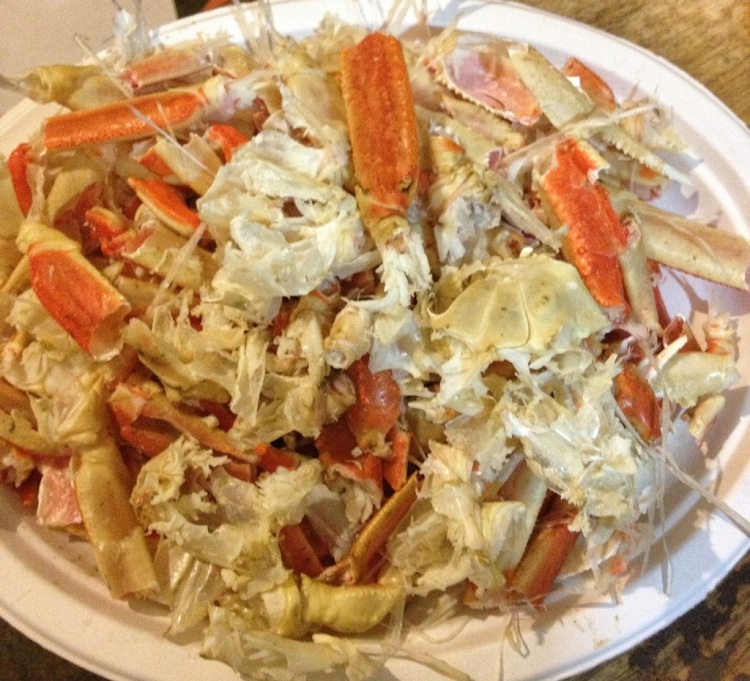
I did not eat that many myself, thank you very much.
The next day I make a stop at a nursery and get some French marigolds (What?!)
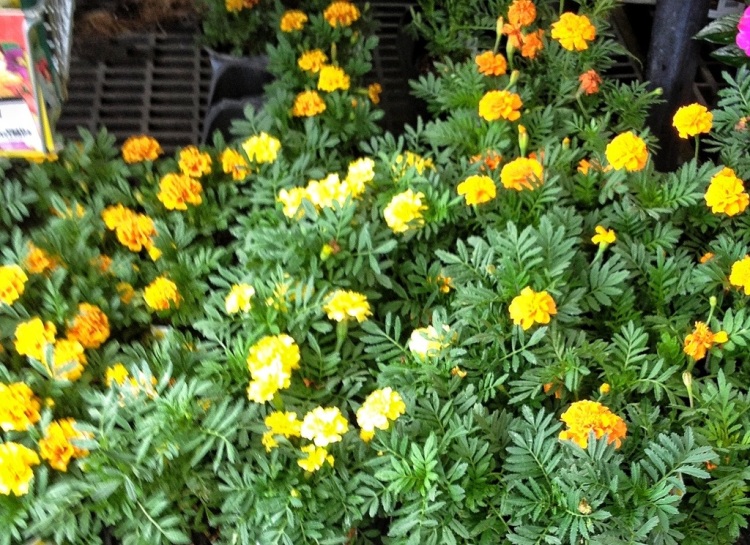
When I get home I start to process the shells.

I don’t really want any of the meat left in the shells.
“Wait!” You say
“What in the hell does this have to do with bonsai?”
Ok, I guess I should explain.
Today’s tree is a Brazilian Raintree.
If you remember, in the last post, I spoke a bit about nitrogen fixing nodules and that their structure bears a resemblance to nematode damage.
I have a BRT with root knot nematodes and we can compare and contrast the two.
Lets define our terms:
What is a root knot nematode?
It is a microscopic (In this example. There are some large nematodes too), unsegmented, round worm. In the case of the root knot nematode, it feeds on the roots of plants, causing them to, well, look knotted. Obviously,this creates problems for the plant.
Here is a look at our roots
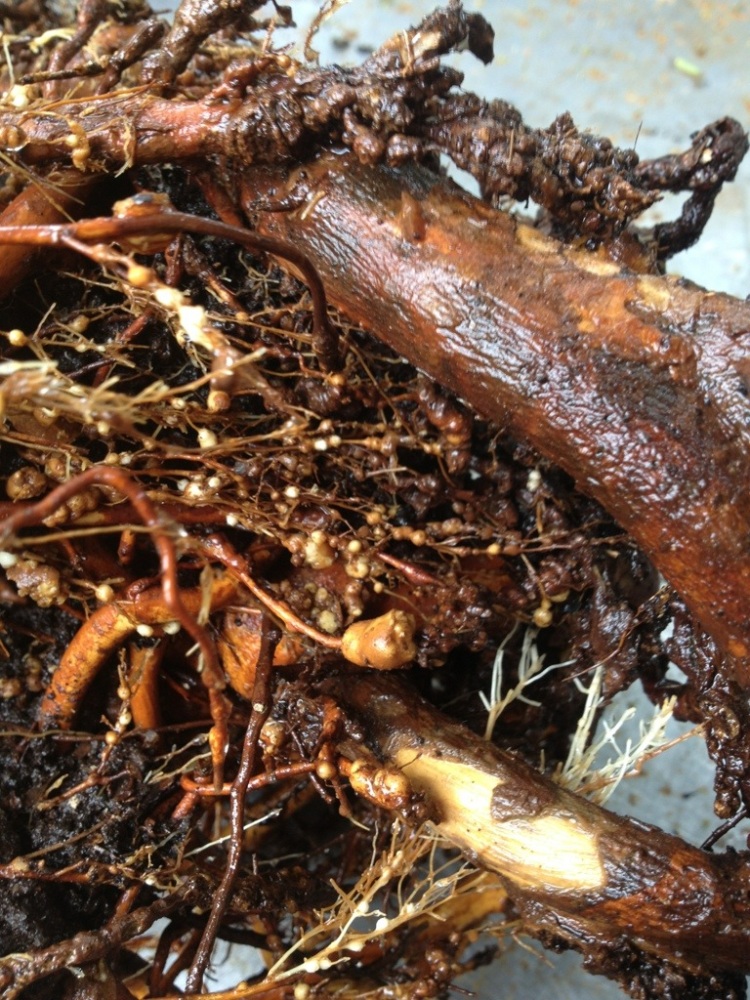
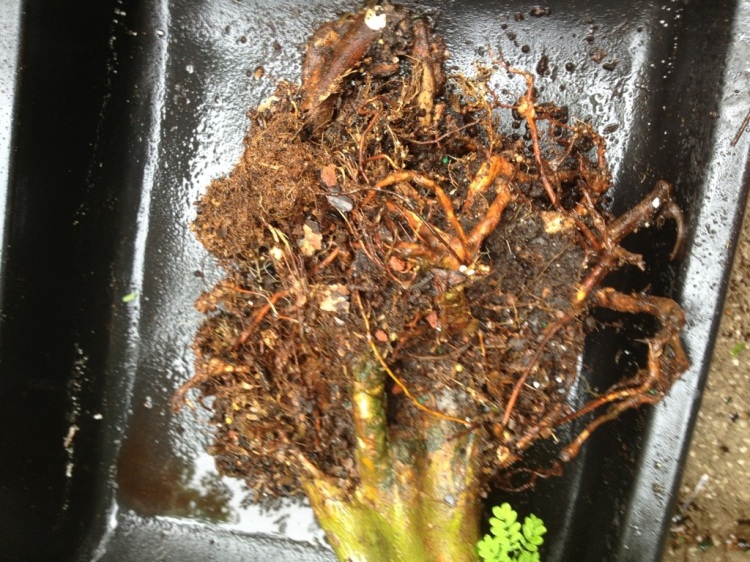
This last may be a beneficial nitrogen fixing nodule.
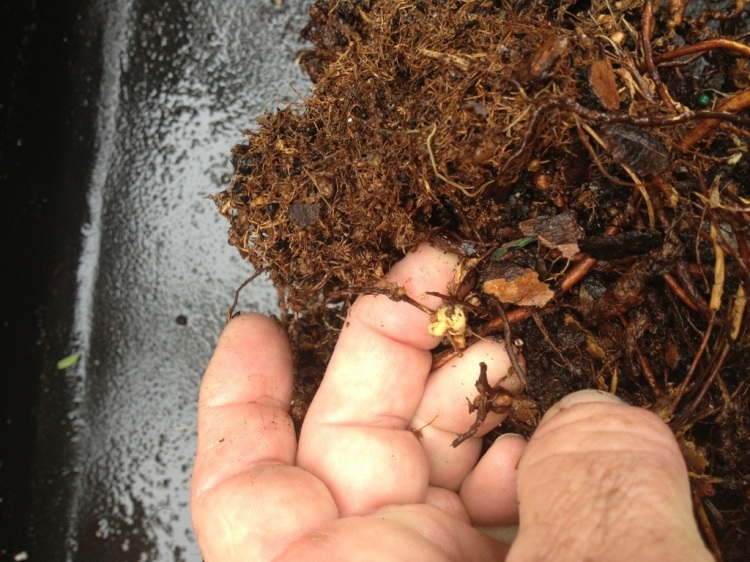
Heres a pic that I know for sure show the nodules (from the last post).
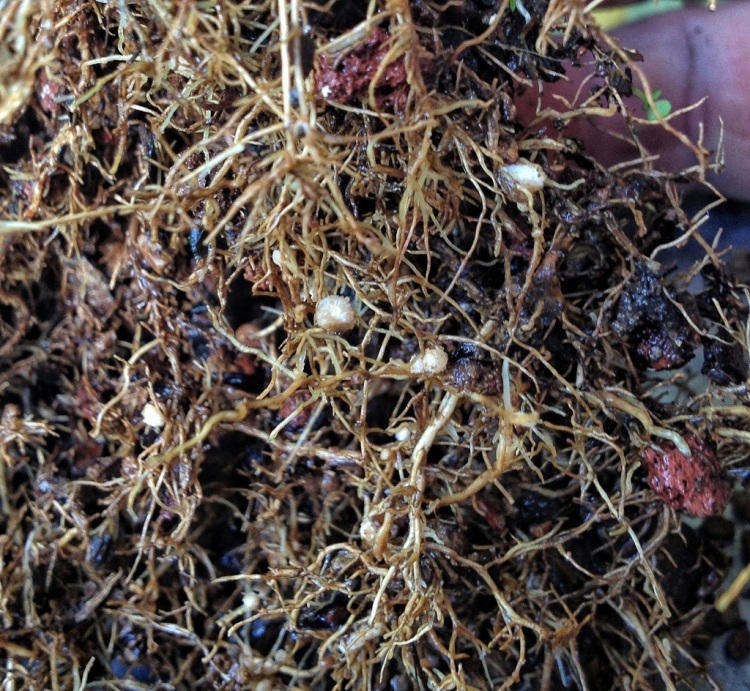
And a singular nodule. You can knock them off the root.
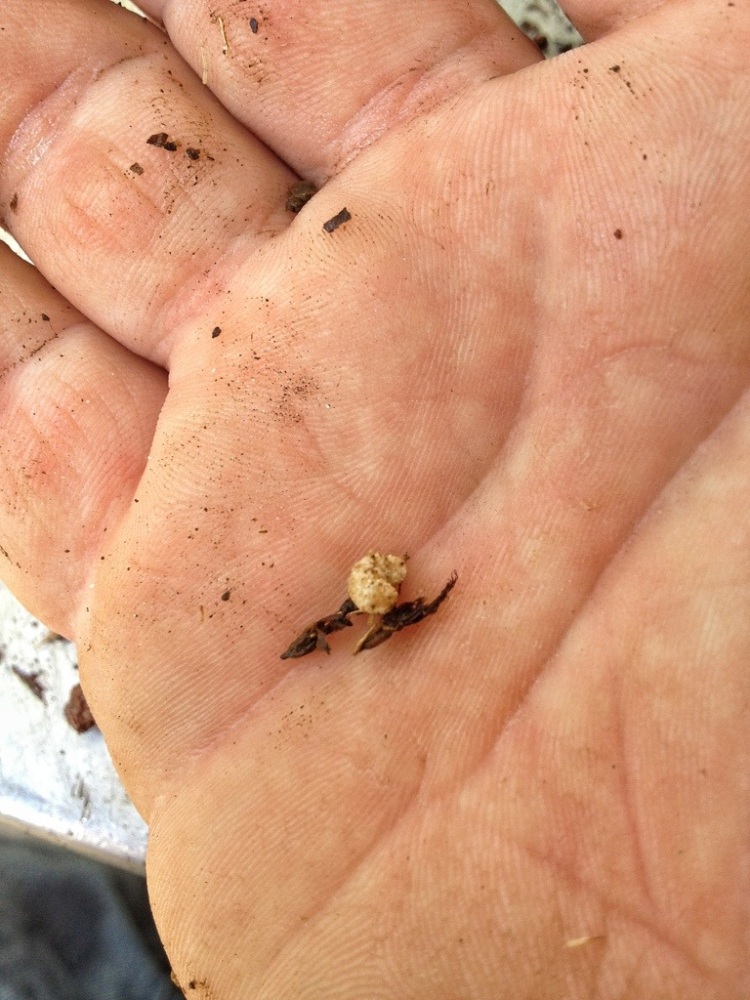
The two look similar but the way to tell the difference is this: the nodule will be attached to the side of the root and can be broken off without cutting the root- the nematode damage invades the root, inside, so to speak and is a part of the root. To remove it you have to cut the root off above the “knot”
Like this

The amazing thing is, the mechanism that causes the good nodule formation is exploited by the nematodes when they invade the roots.
How do we combat this insidious attack?
I’m trying three approaches.
A triple threat, ka-ching!
One involves the crab shells.
Another involves the marigolds.
And with the third I will try diatomaceous earth.
How does crab shell work?
Put simply, crab shells are made of (among other things) chitin.
There is a bacteria that eats this chitin.
The eggs and parts of the bodies of nematodes are also made of chitin.
The idea is that by increasing the food available to this bacteria (with the crab shell) you will get more bacteria. And this bacteria interrupts the life cycle of the nematode and, no more worms.
For a very detailed explanation go here.
It took me a week of Internet searching to find that page. You’re welcome.
And that explains the crab shells.
Back to the processing.
I will say this; this is truly the first time my wife, the self described bonsai widow, has been enthusiastic about helping me with my trees.
Now I have to clean and chop the crab shells. She said I was on my own there.

I am here to say, even just a scant 20 hours after cooking them, the shells stink. Really. Really stink. Really.
I want to clean out all the meat because I do not want that smell in my nursery. I pick on my friends that use fish emulsion as fertilizer. I can’t wait to hear the jokes now.

This bit above was one of my leftovers I’m sure. My wife does not let something like that happen. She is very good at handling meat.
Ahem.
So I cut, crush, wash and scrub these bastard shells for a few hours.
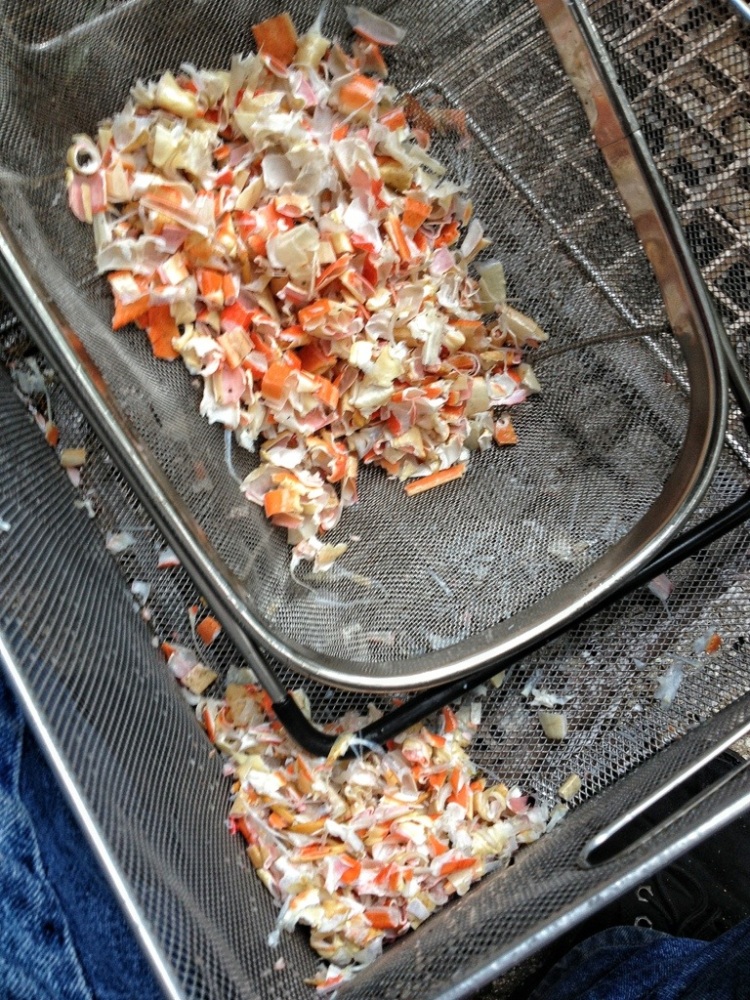
And this is all I get.
Remember, I started with this

It’s enough though.
This next pic you should print and frame

That’s the cleanest you’ll see my hands ever. Shells make a good exfoliant and scrub I guess.
So, I take my shells
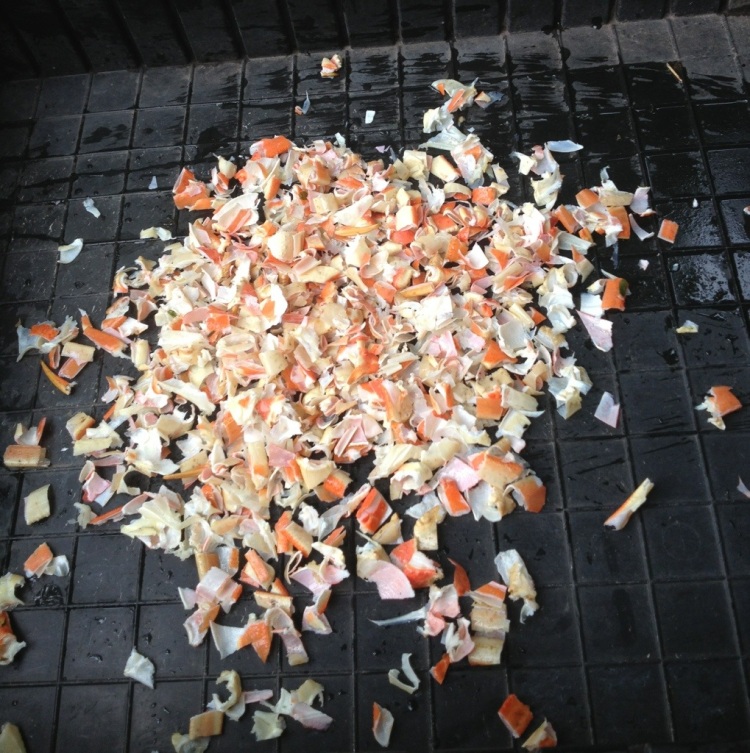
Add my bonsai soil

And then add some granular diatomaceous earth.
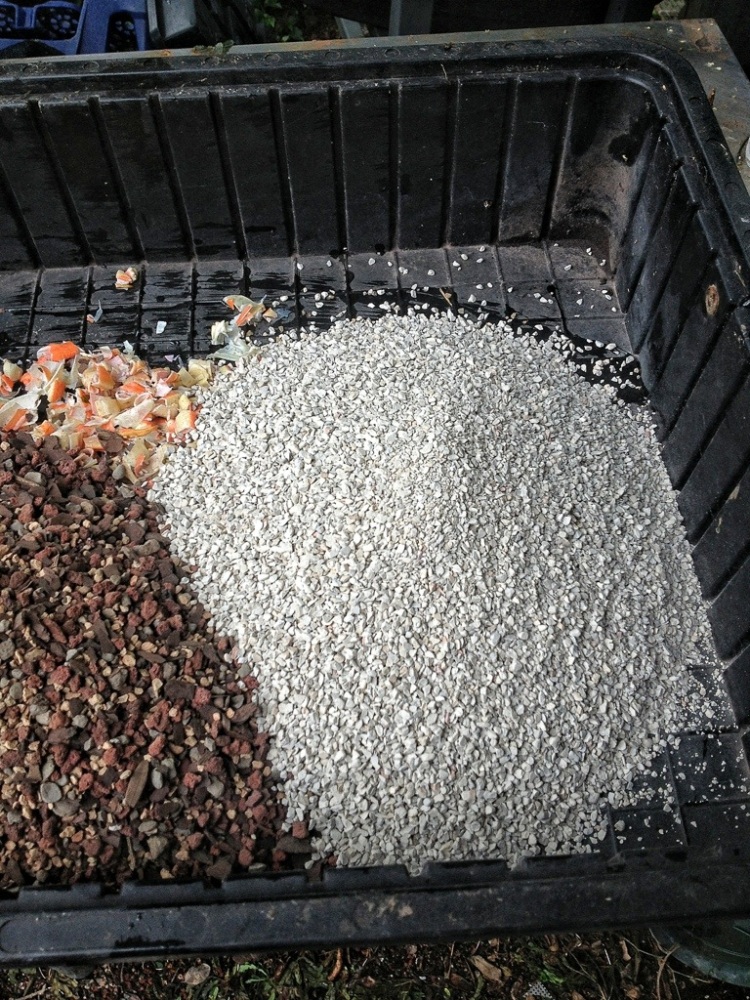
Why the DE?
DE is very abrasive and will cut and scratch holes in the skins of the nematodes and their eggs, making them even more susceptible to the bacteria.
I think.
The idea is totally theoretical on my part.
It is sound though because it works on bugs and such. The only evidence I found as to DE working on nematodes was as an inter-intestinal anti-parasitic feed additive for animals (and people).
So it probably will help, and it can’t hurt.
Not like this next step, the risky part.
I must prune out all the infected roots.
Yup.
All of them. Once the nematodes are inside the roots everything I am doing won’t have much effect at all.
Here goes nothing.
The soil the BRT was in is totally broken down gunk. Yuck.

So I wash it away and then use a saw to cut back most of the roots
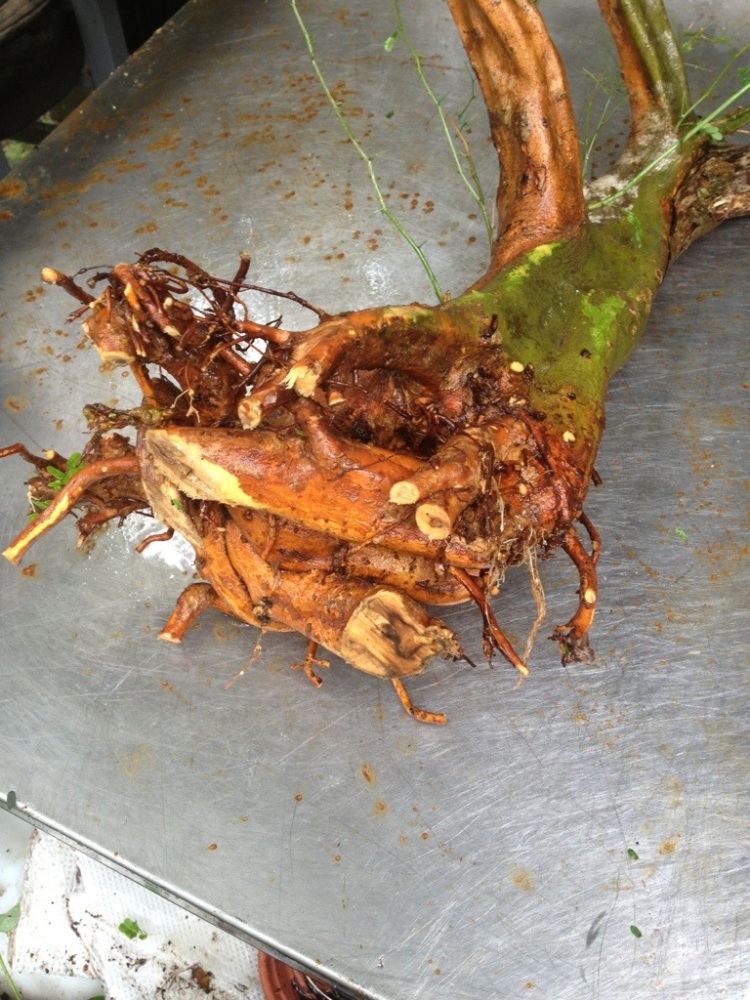
Kinda scary, isn’t it. There might be a handful of feeder roots. Maybe. No more than that (when I say a handful I mean, like 5. Not as much as will fit in my hand)
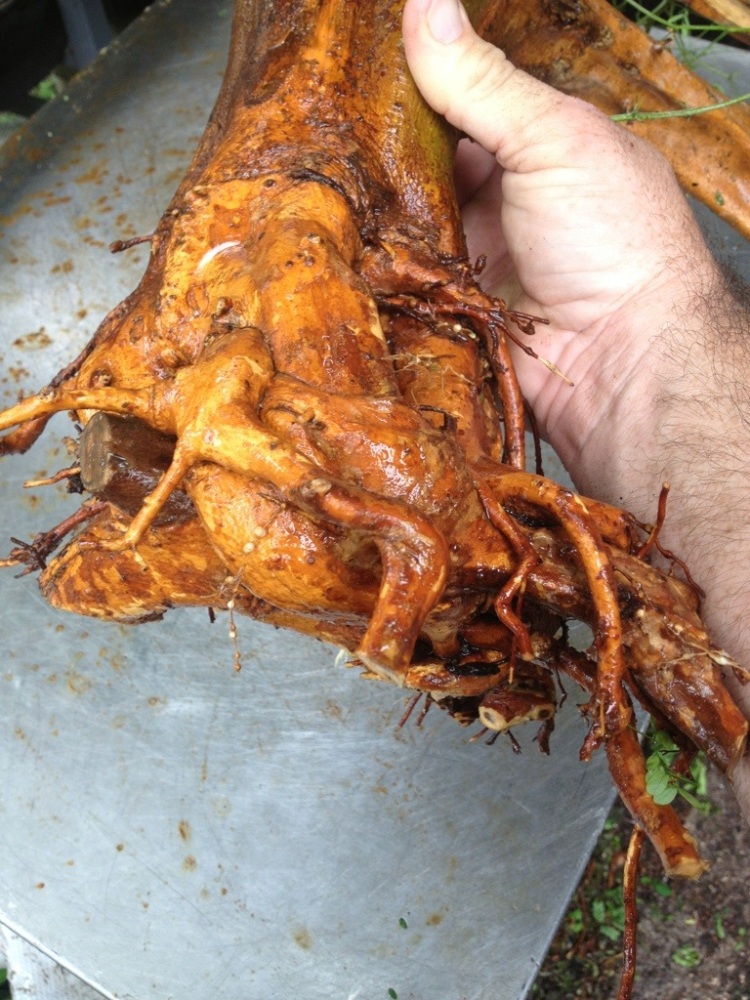
In the hopes that I can stimulate some root growth I defoliate.
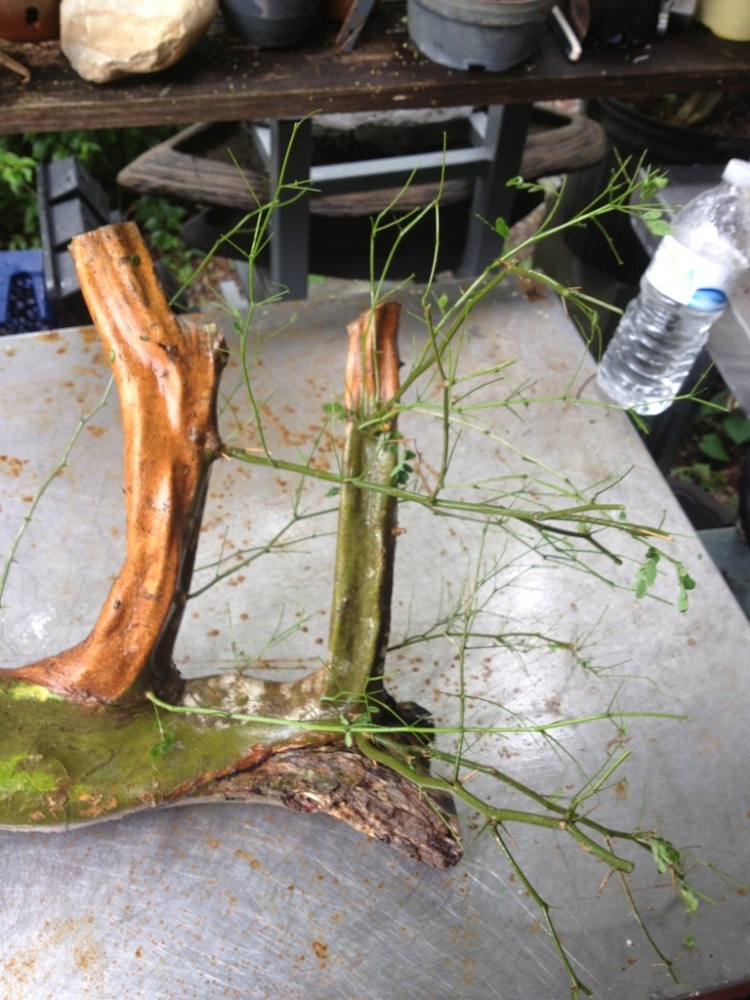
Cross your fingers my dear, dear readers.
Nothing to do now but pot it up
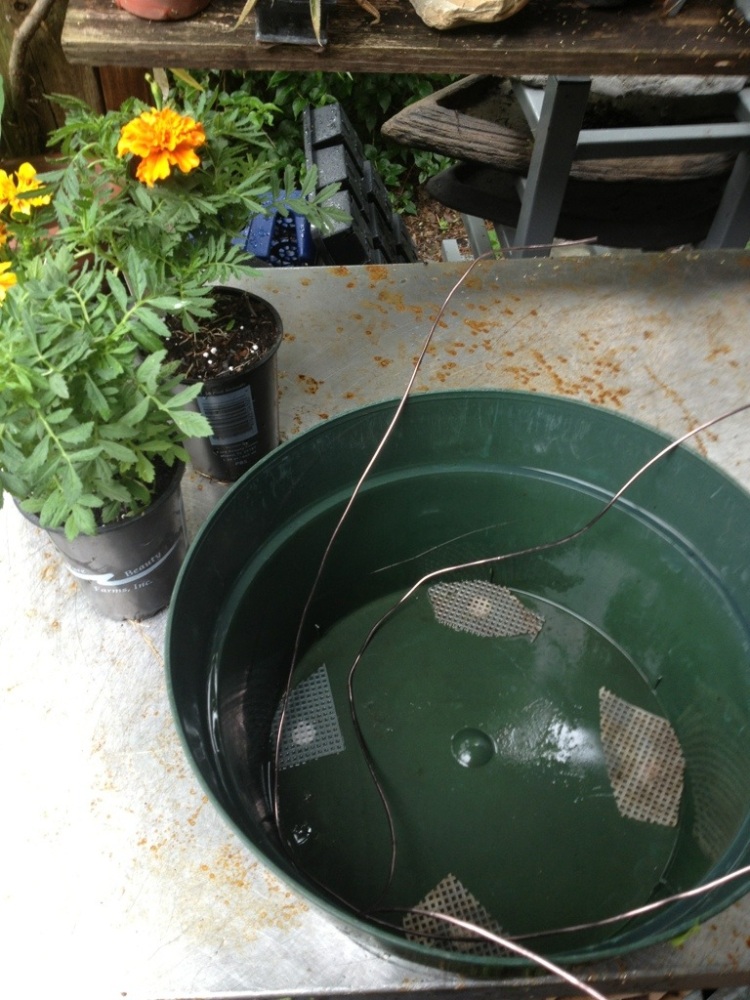
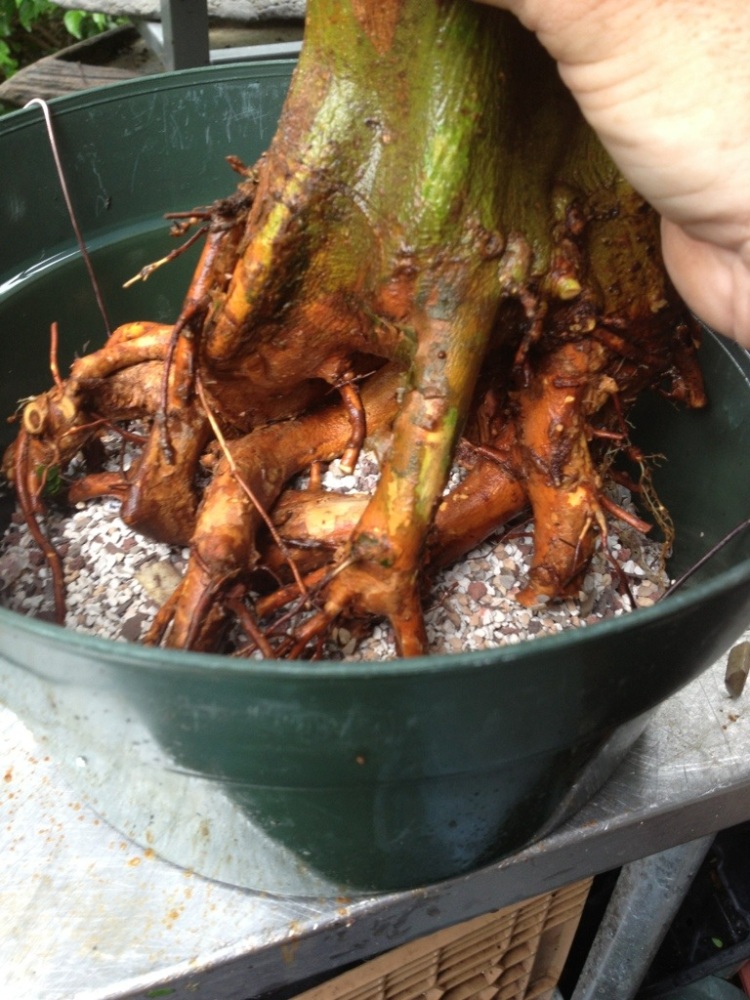
I make sure that it’s very secure in the pot. The less movement, the easier it will be for new roots to establish.

And I make sure that there are no air pockets.
And now, I plant the marigolds

What, pray tell, are the marigolds for?
Well……
First, make sure they are French marigolds (tagetes species:there’s actually a variety called Nemagold ).
The marigold (depending on who’s article you are reading) either has nematode killing chemicals or is a trap plant (which means the nematode enters the roots, gets trapped inside, and is prevented from continuing its life cycle)
Some literature says that the use of marigold is not effective until the next season.
Most old-timers, though, swear by them and still plant marigolds interspersed within their crops anyway.
I’m planting them in the pot. It won’t hurt.

I spent a lot of money on this Brazilian Raintree. I’m not taking any chances.
And here it is.


I will not jinx myself by thinking about how to style this tree yet. It has a lot of deadwood for me to carve, which is exciting. Right now, though, I just hope it can pull through.
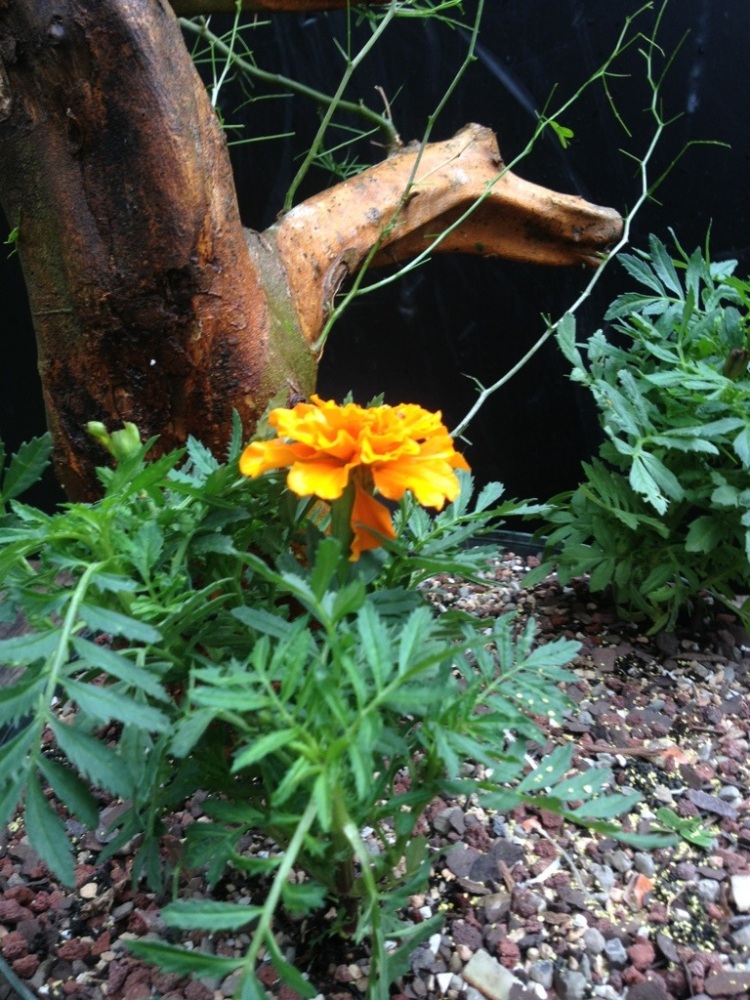
I am cautiously optimistic. I showed the pictures to my friend Erik. He says that he’s cut back the roots even more than this and the BRT lived.
There is a commercially available product made by a company called Neptune’s Harvest that you can use instead of eating and cleaning the crabs yourself. That’s what Erik did.
There is also a chemical control that’s only available to growers so I couldn’t try it.
One last thing.
I make absolute sure that I clean my tools and my work station with bleach. The root knot nematodes can infect a plant very easily just by incidental contact.
And keep your susceptible plants off the ground. It just takes two (a male and female) microscopic worms to have a party in your pot. A pot party, so to speak.
Like I said, they are insidious.
Wish me luck.
Good luck with the nematodes. Now — can you get Winn Dixie to return to SC?
LikeLike
I’m gonna need it with the nematodes. And I’m not on the board of directors of Winn Dixie, sorry.
LikeLike
….and yet another reason why I follow this blog! Sometimes I think who else but me would come up with these solutions, that I am crazy, driven, off-the-wall, and then I realize there’s also Adam. Thanks for a great post, and I hope you kill the bastards!
LikeLike
Always a great blog and VERY educational! Does the foliage show evidence of nematode damage, or it is discovered during potting? Are nasty nematodes prevalent in any particular part of the country vs others….any species more prone than others? Thanks for the BBB! (Best Bonsai Blog)
LikeLike
The foliage will be off color and weak. And not grow much. Nematodes are more prevalent in the southern states. Where soil does not freeze.
In bonsai buttonwoods, bougies, Fukien tea, Chinese pricey and BRT’s of course. Black pine as well in field grown trees in florida
LikeLike
With that general of a description I can’t help but wonder if I’ve got some trees with it myself (especially since almost everything I have is a bougie), would never have considered nematodes in seeing those symptoms so very glad to have read this thanks as always Adam!!
Will keep a sharp eye for them while re-potting things this month, also think I’m going to try and acquire some Temik this post has me real scared of nematodes!! Would love to know how the tree’s doing now, I can tell by your updates in these comments that it’s still going (at least it was several years after the original post!) but would be interested in knowing if the nematodes are fully eradicated or just managed (like a recurring aphid problem maybe)
Thanks as always (and awesome BRT material there!!!)
LikeLike
Wow, major research and dedicated work. Plus, your “bonsai widow” wife is a saint, sacrificing herself (swoon! sigh!) in the kitchen so you can continue your diligent work with your trees. :]
LikeLike
You’ve lost your mind.
LikeLike
Yes sir!
LikeLike
Hmmm…. I know for a fact that Mike’s lost his mind, maybe he won’t notice if all of ~his~ soil goes missing…. 😉
LikeLike
Actually, I work with beneficial nematodes to combat mole crickets and also find soil types can reduce sting and other type of nematodes… Great work, really!
LikeLike
Really perfect works. If possible, we like to provide bonsai pots free for you because we really love your bonsai very well. All materials is eco friendly. Website http://www.daddypots.com/ . Contact me at david@daddypots.com
LikeLike
Thanks David. Thanks for the offer but I’m not really a pot dealer. I work with the trees
LikeLike
Any updates to this project?
LikeLike
The tree still lives but I haven’t checked the roots yet. It went through winter well with very little leaf drop.
There have been big areas of die back on it.
I will be working on it soon and I’ll give a good write up on it
LikeLike
Thanks Adam. I have two large BRT’s here with nematodes. I am going to try bleach for one and ammonia for the other and see how it goes. I will document the process and results.
LikeLike
Let us know, I wouldn’t really recommend that myself but if it works I’d be interested to hear
LikeLike
I was feeling pretty happy with myself today…. Four! Count ’em! Four roadside podocarpuses (podocarpi?) until I got them home and looked at the roots… and sent pics to a friend… and he said nematodes… i’m not attached to them yet… I can throw them back to the curb, but would just removing the vast majority of the roots work?
LikeLike
Don’t throw them away just yet! Podocarpus are one of the trees with nitrogen fixing nodules. So don’t worry and get them into some soil.
LikeLike
ha. soil. they’re gonna have to be ok cradled in some sphagnum moss for a little while… and i’m gonna have to eventually restock my mom’s garbage can o’ sphagnum… gonna have to dig up that post on soil and look into availability and pricing of those components in my neck of the FL woods… it’s sad when perlite is a step up from what you had before… i’ll get there one day, though!
LikeLike
yay! i figured i’d see if they came off or if i’d have to cut them off, and they popped right offa there! whoohoo! wonder if Mike might want one or two of them… it’s like finding a litter of kittens that need a home, you don’t want them suffering on the side of the road, but dangit, who has room for all these plants?! 😉 (at least they’re not pooping all over the place, though, right?)
LikeLike
Any updates on this guy Adam?
LikeLike
Wow, that is rough looking in the final shots.. Can’t wait to read the update.
LikeLike
What is the tree species? I would like to identify this nematode to species. If you still have problems, let me know and I can do it for you.
LikeLike
Hi Jon, it’s a Brazilian raintree, chloroluceun tortum. The nematodes are Florida nematodes if that helps you out a little.
LikeLike
Thanks for the reply.
I am a taxonomist that specializes in root-knot and I am curious as to the species that you have. Do you have any material that you could send to me?
Thanks,
Jon
LikeLike
Hello Adam, Jon. I wanted to squeeze in for a minute. Many of us, including myself, have been searching for a cure for the past 7 years. I have been following this post for many years.
I was able to cure one tree for two years. The infestation returned on the third year. This method would have been successful if I had retreated the plant three more critical times in that period. We are trying another round of this method later this year. Every step of the cure is documents in HD film. With any luck it will be released as a short video in a few years.
Pasteuria Penetrans. We have been working with Dr Tesfa and Dr Sekora(Nematologist) in relation to nematodes on BRTs for several months. We are in search of a cure. Dr Sekora has three samples and a ton of data collected. We hope to have an organic cure within 24 months.
@ Jon. You can contact Dr Sekora at “nsekora AT nematology.solutions” if you have any information that will speed this process up. Tell him Jack sent you. I think he has some slide shots ready as well. He plans on doing a write up on the issue later this year. The scope will be limited to nematodes and BRTs.
Temik is no longer banned but it is heavily regulated. http://www.aglogicchemical.com/ offers it. It will never be labeled for ornamental use. This product will absolutely destroy nematode colonies. If we could only get a bottle to eradicate nematodes from high end bonsai material in one shot.
Thanks
Jack
LikeLike
Thanks Jack
LikeLike
Jack,
Thanks! I will check with Dr. Sikora to see if he has identified this root-knot species.
Best wishes in your search for a cure.
Worm regards,
Jon
LikeLike
Worm regards, jeeze….
LikeLike
Adam will Blue Crab backs work also? Seems you can get them cleaner and I possibly get as many as them as I would like. My Brother in Law’s Brother is a commercial crabber.
LikeLike